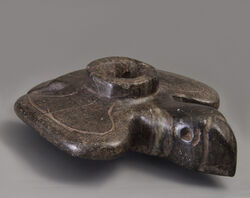Bird in flight
October 2022

With a length of more than twenty centimeters and a weight of more than one and a half kilos, this majestic tobacco pipe is a beautiful example of a ceremonial tobacco pipe. It must have been quite a tour de force to realize such a piece. That is certainly the case when we consider that this object dates from American prehistory, about a thousand years ago, at a time when metal tools were not yet known there. The pipe is an example of Mississippi culture, the last prehistoric culture of North America before the arrival of the Europeans. The highly hierarchical society was well organized in various cities, of which only their burial mounds remain. That is why the people are later referred to as mound builders. Similar pipes have been found more often by American archaeologists. Usually such large-sized pipes are made of steatite, but this is a harder type of stone. Especially the track with quartz that runs diagonally over the pipe bowl must have required a lot of extra grinding time. Hard stone is not easy to work with, which is why the design focuses on two elements: to lay down the contours of the animal and then to apply only a few details. That design is beautifully done, stylized but powerful. The maker had more trouble with the details. For example, the lines along the wings are wavering and less taut than you'd hope. Still, the achievement commands respect in every way. There are several known variants of this concept, identified by experts as a flying falcon, so that it appears to be a type. Although the pipe can be smoked with a wooden stem inserted into the tail, it is clearly a ritual object, a product intended for a funeral ceremony. During that ritual the pipe was often buried and it took centuries before it was rediscovered. It seems a miracle that the heavy object was found intact, but that is understandable if we know the hardness of the stone and consider the ritual use. Likewise, this pipe emerged one day as an artifact of a long-lost tradition.
Amsterdam Pipe Museum APM 24.576
Permalink